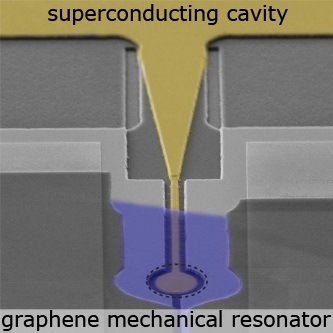09 August 2016
When miniaturizing mechanical systems to the nanoscale, the force sensitivity of these ultra-light resonators is often limited by the imprecision in the measurement of the vibrations. However, the use of graphene, carbon nanotubes, semiconducting nanowires, and monolayer semiconductors, allows the exploration of the ultimate limit of force sensing. The mechanical force noise of these resonators becomes extremely small and therefore permits the possibility of studying physical phenomena in extreme conditions, inaccessible with other methods.
In a recent study published in Nature Communications, ICFO researchers Peter Weber, Johannes Güttinger, Adrien Noury, Jorge Vergara-Cruz, led by ICFO Prof. Adrian Bachtold, have achieved unprecedented ultra-sensitive measurements on graphene mechanical resonators, surpassing previous studies in terms of force sensitivity (390 zN Hz-0.5), displacement sensitivity (1.3 fm Hz-0.5), and phonon occupation (7.2 phonons).
The force sensitivity obtained by the team approaches the fundamental limit imposed by thermo-mechanical noise at sub-Kelvin temperature. To readout mechanical vibrations with high precision, the team strongly coupled the graphene mechanical resonator to a superconducting cavity, obtaining a displacement sensitivity one order of magnitude better than sensitivities attained so far. They were also able to sideband cool the graphene motion to an average phonon occupation of 7.2 phonons, approaching the quantum ground-state regime, and surpassing all previous cooling results on mechanical resonators based on graphene, carbon nanotubes, semiconducting nanowires, and monolayer semiconductors.
The results obtained in this study pave the way towards ultra high sensitivity force sensing based on nanoscale systems in order to explore new physical phenomena in nuclear spin physics, quantum electron transport, surface science, and light-matter interaction.

Force Sensing achieved with Graphene Opto-Mechanical Resonators
ICFO study achieves unprecedented ultra-sensitive force measurements with multilayer graphene optomechanical devices.

Scheme of device with the graphene mechanical resonator located inside the dotted circle.











